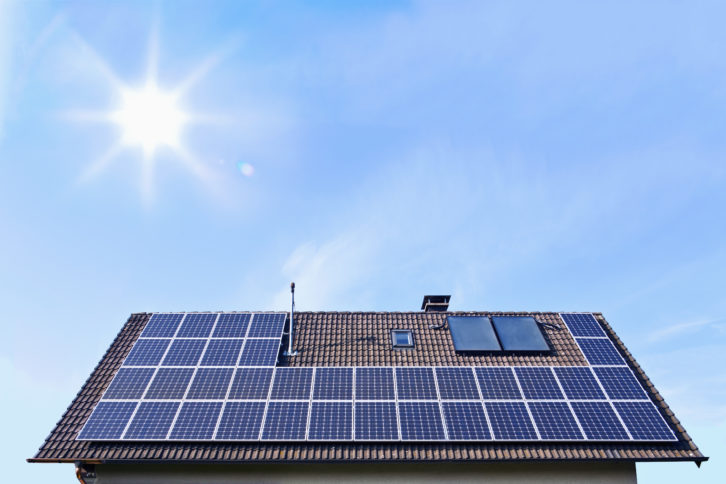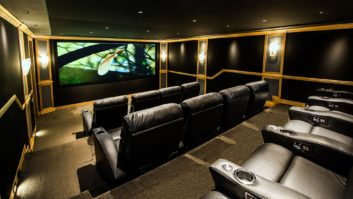
You probably know by now that I am a big fan of feeding our audio, video, technology, and automation systems with very clean and stable power. I find that there are less gremlins and equipment failures, and also better AV quality when you start with a noise-free, stable 120 V/240 V sinusoidal power supply. It’s also really nice to have uninterruptable power in the case of brown-outs or black-outs, so that our customers can enjoy movies and music regardless of the conditions outside that virtual reality bubble we create for them.
If you can get your hands on an oscilloscope — either the old full-sized type or a USB-controlled interface type — take a look at what lives on the power line these days. Instead of a nice, clean sine wave, you will mostly see flat-topped, noisy, and glitchy waveforms.
Also by Anthony Grimani: A Battle Royale for Home Entertainment
In the olden days of ballsy analog power supplies, this didn’t matter too much because the rectifier and storage and filtering capacitors would largely smooth it all out. They couldn’t, however, regulate the voltage swings or bridge the gap of a temporary interruption. Modern-day switching supplies can regulate around the voltage variations, but won’t do too well with all the noise. That’s where all the glitches, gremlins, and system failures can originate. Computing equipment with inconsistent or noisy supply voltage or ground noise will start to spew out invalid data, and failures cascade from there. Automation and security systems are computing devices; networking systems are computing devices; audio processors are really just computing devices with audio signal I/O; and video displays are, for that matter, computing devices with video signal inputs. Get my point? It’s all guaranteed to be flaky if the power line is flaky.
So what to do, you say? The most ideal AV/home technology deployment looks like this to me:
- A large bank of storage batteries, the number of which is TBD below.
- A really high-quality inverter that turns the DC power in the batteries into perfectly stable and low distortion sinusoidal 120 V AC mains voltage. The inverter would also have a low output impedance with enough output current load capacity to drive your system with +20 percent for margin. At the full rated load, its output voltage should not deviate by any more than 5 V. As an option, you can insert a high-quality isolation transformer that will further reduce the output impedance and clean up any noise.
- A bank of breakers fed from the inverter or transformer to segment the systems into useful groups such as line level devices, switchers, and sources; audio amplifiers; control, networking, and security systems; video displays; etc. All theater and house equipment will be fed by outlets that come from these breakers, and you will designate these outlets as hospital-grade “clean power” in the usual red or orange color. The breakers should all be IoT-enabled, so that you can do full power reboots by remote if needed.
- A battery charging system that takes power from the grid and also keeps the batteries at the perfect voltage in trickle charge, so as to optimize battery life.
- …and while you’re at it, a set of solar photovoltaic panels that can keep the battery bank charged during daylight hours.
Here’s where you fit in: Figuring out the proper infrastructure for the managed local power system takes some engineering as well as some thorough product research if you want all the specifications just right. With the advent of solar power, there are now literally dozens and dozens of companies that make these components in various grades of performance, quality, and price.
I visited the InterSolar show in Munich a few months back, right after the High End Audio show there. InterSolar filled most of a very large convention center, and they had visitor traffic that would be the envy of any of our AV shows. The array of choices was dizzying. Judging from the size and quality of the booths, there is a lot of money circulating in this business. My point is not necessarily that you should get into the solar power business, but instead that you can leverage the technologies and products from that market segment in order to provide stable and repeatable power foundations for your projects. You will make some added income by engineering, selling, and installing the power management scheme, and you will stop paying out of your pocket for the endless debugging and service calls that come from glitchy power from the utility company.
Also by Anthony Grimani: Keeping an Eye on Your Systems
While you’re at it, once you have installed a charging system, a bank of batteries, a good inverter, an IoT breaker package, and clean power outlets for all your gear, you may as well encourage the home owner to look at getting solar panels in order to be independent of the power grid — and lower the energy bill. You can handle the work yourself or partner up with a solar company who will be happy with the referral.
Solar becomes very useful in the Western states that will have rolling blacks-outs this summer to protect from wildfire hazards. Even with a two-day utility interruption, all your gear will keep on working. Your clients can continue watching movies, surfing the internet, and checking the status of their home security — all within the safety and comfort of their virtual reality bubbles.
Talk about an added feature that your clients will thank you for!
Anthony Grimani ([email protected]) is president of Grimani Systems, PMI Engineering, and Dimension4 Acoustics, with offices in San Francisco, Los Angeles, and Paris.
Chase Walton ([email protected]) contributed to this article.
Want more stories like this delivered to your inbox every day? Then sign up for the free Residential Systems eNewsletter here.




